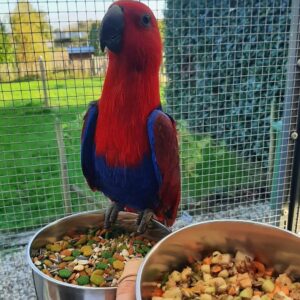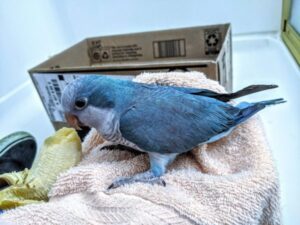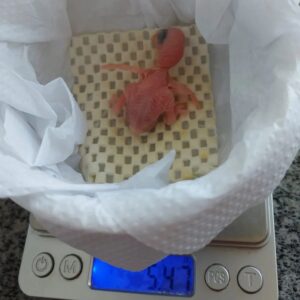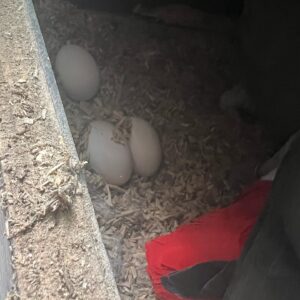As the saying goes: you don’t own the parrot; the parrot owns you. Parrots are complex and emotional beings with care needs that surpass those of dogs or cats.
Many experienced owners compare sharing a household with a parrot to living with an intelligent toddler.
Not only are parrots great puzzle solvers and quick learners, but they also experience many of the same emotions as humans. No one should get a parrot without being prepared for that commitment.
Are you ready for a long-lived parrot that’ll require several hours of your time each day? All parrots present different challenges, including:
- Emotional tantrums.
- Territorial disputes.
- Hormonal aggression.
The larger the parrot, the more challenging it’ll be to care for, train, and handle. However, larger parrots can often learn more words and tricks and show a broader range of human-like emotions.
What Is A Good Parrot for A Beginner?
There’s no such thing as an easy-to-care-for pet parrot. However, these species are considered quick learners, fun, affectionate, entertaining, and friendly toward their owners:
1/ Budgerigars (Budgies)
- Size: 7-8 inches tall.
- Weight: 1 to 1.4 ounces.
- Lifespan: 7-15 years.
- Cost: $20 to $40.
These small parrots have colorful plumage and are sweet-natured. Tremendously social, budgies are very friendly and affectionate once trained. Budgies enjoy vocalizing and practicing with their owners, but their voices can be gravelly. Budgies (American parakeets in the U.S.) are famous for their ability to develop an extensive vocabulary.
Many owners acquire several budgies, which is ideal because budgies are social birds that like company. Two budgies will get along well as long as you combine:
- Two males.
- A male and female.
Two females may have more frequent conflicts. If you acquire 1 budgie, you must dedicate more time to socialization because it’ll rely on you for company and engagement.
American parakeets are lively and talkative, so a happy, healthy bird will constantly sing, chatter, and chirp. A quiet budgie is sick or unhappy.
Despite their small size, budgies can be quite demanding, to the extent of being bossy. However, English budgies are quieter than American budgies, so you may wish to consider them as an alternative.
2/ Cockatiels
- Size: 12-13 inches tall.
- Weight: 2-4 ounces.
- Lifespan: 10-15 years.
- Cost: $80 to $250.
Cockatiels are loving, friendly, and outgoing birds. Females are usually gentler, as males sometimes get moody when they don’t receive the constant attention they crave.
Very playful by nature, these medium-sized birds get along well with their owners.
They require a minimum of 2 hours of playtime outside their cage daily. So, they should be given a large cage and multiple perches and toys to keep them entertained.
An interesting feature of the cockatiel is its crest. Aside from being beautiful, it’ll help you understand the cockatiel’s mood. A flattened crest could mean it is stressed or scared. Meanwhile, a raised, spread-open crest may tell you it’s interested, intrigued, or attentive.
While cockatiels aren’t talkative, preferring to whistle, they’re adept at learning and following commands. So, teaching cockatiels tricks and playing together will be an enjoyable experience.
Cockatiels don’t live as long as some parrots but have a life expectancy of around 15 years.
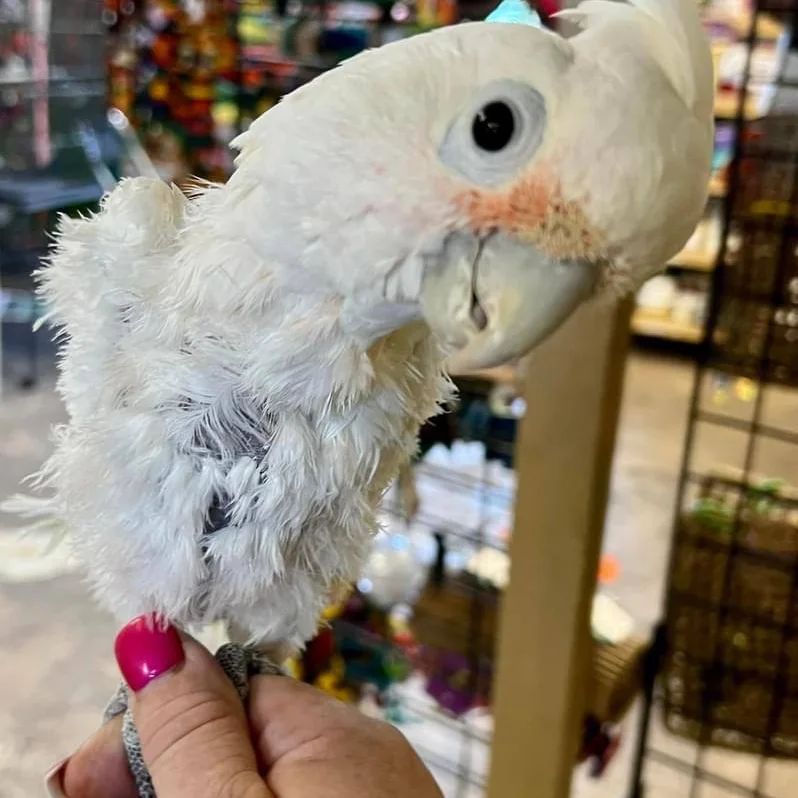
3/ Green-Cheeked Conures
- Size: 10 inches.
- Weight: 60-80 grams.
- Lifespan: 10 to 15 years.
- Cost: $150 to $350.
Green-cheeked conures have gained popularity recently due to their affectionate personalities and relatively quiet demeanors. Conures are ideal for those who’d like a larger parrot without the constant stress that macaws and cockatoos bring. Conures quickly learn tricks and a few spoken words and enjoy playing with their owners. They’re a good option in family homes, as they’re not necessarily one-person birds, meaning various household members can enjoy quality time with these beautiful creatures.
Conures aren’t aggressive but can be moody and bite if not trained correctly. So, being consistent and dedicated to their training is important, especially when they’re young.
Green-cheeked conures can be quite comical and active, performing acrobatics. Like cockatiels, they require ample space to fly and move around.
They love shredder toys and spending time with or near you. Green-cheeked conures are affectionate to their bonded owners.
4/ Senegal Parrots
- Size: 9-10 inches.
- Weight: 4-6 ounces.
- Lifespan: 30-40 years.
- Cost:$500 to $800.
Senegal parrots enjoy playtime and handling, making them ideal for a pet bird. They’re naturally shy parrots, so they can be one-person birds that are unhappy around crowds. Senegal parrots make excellent companion birds because they live for up to 40 years. They’re sensitive to their surroundings, reacting negatively to sudden changes in decor.
Senegal parrots are among the quietest parrots, making them ideal for people living in apartments. They don’t tend to screech or scream as much as other parrots.
Instead, they enjoy whistling occasionally, so listening to you is an effective bonding exercise. A Senegal parrot will be content to sit on your shoulder as you watch TV or read. Despite their relatively small size, Senegal parrots need a large cage to move around. Get something escape-proof, as these birds can be clever escape artists.
When it’s playtime, they can be quite acrobatic and display comical antics. Despite their intense facial expressions, they’re surprisingly fun and playful parrots. 5/ Parrotlets
- Size: 5 inches.
- Weight: 1 ounce.
- Lifespan: 15-20 years.
- Cost: $200 to $350.
These diminutive and sassy parrots have loads of personality, charming anyone who gets to know them.
They need 2+ hours of daily attention and playtime with their owners to stay mentally and physically fit. They’re active birds and, if trained properly, enjoy being handled when in the right mood. However, always note their cues and body language to ensure they’re in a playing mood. Parrotlets can bite if they feel overwhelmed or stressed. Although not all parrotlets are big talkers, some learn to talk, occasionally picking up words and phrases. Parrotlets chatter and chirp but aren’t guaranteed to talk.
This species makes great companions, bonding well with their owner if you keep only 1 bird, but they’ll connect more strongly if you decide to get 2 birds.
They get along with other bird species but keep them in separate cages. Parrotlets have feisty personalities and aren’t afraid to boss others despite their diminutive size. 6/ Quaker Parrots (Monk Parrakeets)
- Size: 11-12 inches.
- Weight: 25 to 4.25 ounces.
- Lifespan: 20-30 years.
- Cost: $300 to $600.
The first time you lay eyes on a monk parrot, you might be forgiven for assuming it’s unwell, but don’t let the constant head-shaking fool you.
This behavior is exclusive to Quaker parrots, playing into their name as they quake.
Monk parrots love singing and whistling, sometimes developing an extensive vocabulary.
These parrots are on the louder side, so anyone looking for a quiet pet should look elsewhere.
Check the legal status of this parrot in your state. They’re considered agricultural pests in some states, like California, due to their rapid reproduction rate and predatory behavior toward other birds.
If you plan on getting a male and female, be aware that they lay 4-8 eggs per clutch twice a year, with a hatch time of 21-28 days. If you want to breed parrots, Quaker parrots are a good choice.
7/ Peach-Faced Lovebirds
- Size: 6 inches.
- Weight: 6 to 2.2 ounces.
- Lifespan: 15-25 years.
- Cost: $50 to $200.
We assume lovebirds must be kept in pairs, but they can thrive as single birds.
Despite their name, lovebirds can be quite nippy until tamed. So, spend time with the lovebird giving it training. That way, it’ll be well-behaved and comfortable around you. When kept in pairs, lovebirds are monogamous, so you may feel a little excluded. However, peach-faced lovebirds are quite active, with entertaining and comical personalities. Lovebirds aren’t talkers, but you can expect loud chattering and whistling, especially in the morning. That makes this species better suited to houses with plenty of space.
Lovebirds can be aggressive toward other pets, so they should be kept in separate cages from any other birds you acquire. That’s especially true with budgies, as confrontations are common.
8/ White-Fronted Amazon Parrots
- Size: 5 to 10 inches tall.
- Weight: 5 to 8.5 ounces.
- Lifespan:40+ years.
- Cost: $1,000 to $3,000.
Amazon parrots are medium-sized parrots with high intelligence levels. They’re gifted talkers that enjoy singing, and screeching is one of their favorite past times.
Are White-Fronted Amazon Parrots good for beginners?
White-fronted Amazon parrots are the smallest of all Amazon parrots. They’re gentle-natured since other Amazons are known to play rough, wrestling their owners with their beaks. However, white-fronted Amazon parrots are very friendly and fond of petting.
While they can still bite, white-fronted Amazons can be trained. Their smaller size lends itself well to handling by beginners, as long as you put in the time and effort.
Learn about the parrot’s needs, behavior, and body language. For example, Amazons sometimes go through “play overload,” where they get too excited and carried away when playing. According to Developmental Psychobiology, Amazon parrots can develop serious behavioral problems without enough enrichment.
One advantage of Amazon parrots is their clear and expressive body language. Pinning eyes, ruffled feathers, stances, and vocalizations will communicate their feelings.

White-fronted Amazons can be very loud, so beware if you live in an apartment with close neighbors. Like most Amazons, they learn many words and phrases and can mimic you or their surroundings
9/ Sun Conures
- Size: 12 inches.
- Weight: 4 ounces.
- Lifespan: 15 to 30 years.
- Cost: $200 to $800.
What sets sun conures apart is their lively demeanor and affectionate nature. They can be easily trained, which helps control their somewhat strong personalities.
Are sun conures good for beginners?
Fun and cuddly, they’re open to being handled by different family members as long as they’re treated well. They’re not usually one-person birds. Sun conures are particularly loud, so noise levels can be an issue in smaller apartments. They love nothing more than screaming when they’re having a good time.
Their contact calls are ear-splittingly loud but will be customized to you. Also, sun conures are talented at mimicking you and other household appliances.
Sun conures need lots of open space, so be sure to get a 20 x 20 x 36 cage as a minimum. Sun conures are curious and thrive on exploring their surroundings.
10/ Pionus Parrots
- Size: ~10 to 12 inches.
- Weight: 8 to 9 ounces.
- Lifespan: 15 to 25 years.
- Cost: $200 to $900.
Pionus parrots vary drastically in color from one bird to another, so no 2 birds are the same.
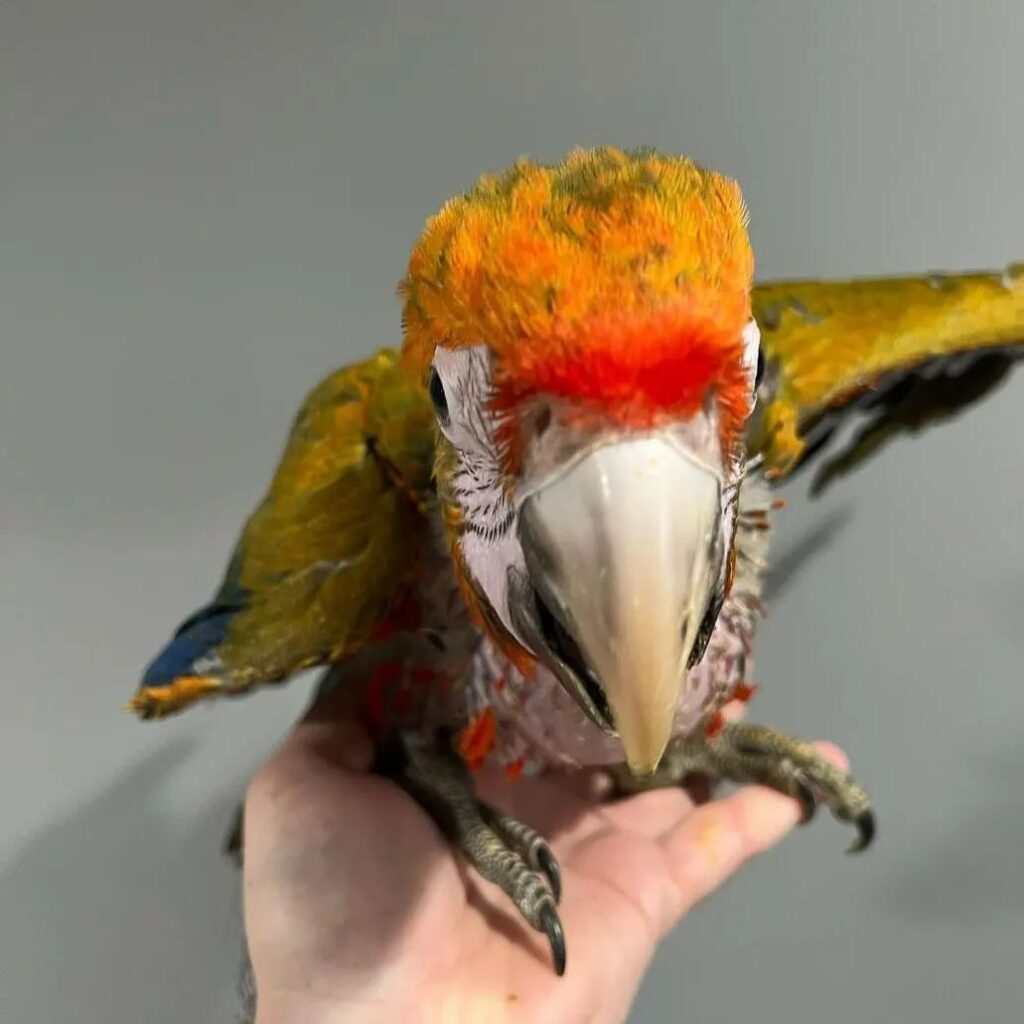
Their lack of notoriety is why many people choose to raise them. Since there aren’t many pionus owners, these parrots have an elusive charm.
Are pionus parrots good for beginners?
Physically, they resemble Amazon parrots but are much quieter and more reserved. They’re known to be somewhat aloof and standoffish but are still easy-going and not known for being aggressive. They can be handled by multiple family members, as they’re not one-person birds.
However, children should be supervised when handling a parrot, as their beaks can cause harm. When stressed or scared, pionus parrots will produce a hissing sound that serves as a warning. Pionus parrots aren’t the most talkative birds. Their gravelly or raspy voices are unclear, but they can learn many words and phrases. How quiet or loud the bird is will depend on its environment.

